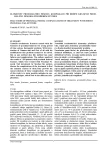Comparison of Reliability of AO/ASIF and Evan’s Classifications
Authors:
Radoslav Morochovič 1; Dana Potočeková 2; Henrieta Blašková 3; Ivan Bugáň 1
Authors‘ workplace:
Department of Trauma Surgery, School of Medicine, University of P. J. Šafárik and FNLP, Košice
1; Klinika úrazovej chirurgie LF UPJŠ a FNLP, Košice
1; Institute of Medical Informatics, School of Medicine, University of P. J. Šafárik, Košice
2; Ústav lekárskej informatiky LF UPJŠ, Košice
2; Department of Radiodiagnostics and Nuclear Medicine, FNLP, Košice
3; Klinika rádiodiagnostiky a nukleárnej medicíny FNLP, Košice
3
Published in:
Úraz chir. 16., 2008, č.1
Overview
Purpose of the study:
There are many of classification systems for grading trochanteric fractures. Of these the AO/ASIF and Evan’s classification systems are widely used. To be a beneficial tool for indicating a method of treatment or permitting communication between surgeons, the classification system should be reliable and reproducible. The aim of this study was to compare the interobserver reliability and intraobserver reproducibility of the AO/ASIF and Evan’s classifications.
Material and Methods:
Plain preoperative and the first postoperative radiographs of 39 consecutive series of patients were classified using the AO/ASIF (with and without subgroups) and Evan’s classifications by five observers (2 ex-perienced surgeons, an experienced radiologist and 2 medical students). The same radiographs were classified by the same observers three months later. Observers agreement was assessed with the weighed coefficient kappa (κ).
Results:
The mean kappa (κ) value for interobserver reliability was 0.43 with the AO/ASIF subgroups (31 A1.1-A3.3), 0.51 with the AO/ASIF main groups (31A1-A3), and 0.37 with Evan’s classification. The mean κ value for intraobserver reproducibility was 0.50, 0.53 and 0.42 respectively. Perfect agreement of all observations in the first session was obtained 18 times (46%) with the AO/ASIF main groups, twice with the AO/ASIF subgroups (5%), and 5 times (13%) with Evan’s classification and 18 (46%), 2 (5%) and 4 times (10%) in the second session respectively.
Discussion and Conclusions:
Our data confirm outcomes of other authors that both the AO/ASIF and Evan’s classifications have moderate to fair inter- and intraobserver reliability with the best mean kappa values for the classification in the AO/ASIF three main groups. Using of early postoperative radiographs for classification did not increase the accuracy of classifying trochanteric fractures in comparison with other authors’ outcomes.
Key words:
kappa statistics, interobserver reliability, intraobserver reproducibility, trochanteric fractures.
Sources
1. Fracture and dislocation compendium. Orthopaedic Trauma Association Committee for Coding and Classification. J Orthop Trauma. 10 Suppl 1, 1996, č. s. v-ix, 32–35.
2. AUDIGE, L., BHANDARI, M., KELLAM, J. How reliable are reliability studies of fracture classifications? A systematic review of their methodologies. Acta Orthop Scand. 2004, 75, 184–194.
3. BARTONÍČEK, J., DOUŠA, P., SKÁLA-ROSEN-BAUM, J., KOŠŤÁL, R. Trochanterické zlomeniny. Souborný referát. Úraz chir. 2002, 10, 13–24.
4. BURSTEIN, A. H. Fracture classification systems: do they work and are they useful? J Bone Joint Surg. 1993,75-A, 12, 1743–1744.
5. EVANS, E. M. The treatment of trochanteric fractures of the femur. J Bone Joint Surg. 1949, 31-B, 190–203.
6. GEHRCHEN, P. M., NIELSEN, J. O., OLESEN, B. Poor reproducibility of Evans' classification of the trochanteric fracture. Assessment of 4 observers in 52 cases. Acta Orthop Scand. 1993, 64, 71–72.
7. JENSEN, J. S., MICHAELSEN, M. Trochanteric femoral fractures treated with McLaughlin osteosynthesis. Acta Orthop Scand. 1975, 46, 795–803.
8. JIN, W. J., DAI, L. Y., CUI, Y. M. et al. Reliability of classification systems for intertrochanteric fractures of the proximal femur in experienced orthopaedic surgeons. Injury. 2005, 36, 858–861.
9. KITKA, M., CIBUR, P., MOLČÁNYI, T., NOVOT-NÝ, Š., ROŠÁK, M. Výsledky a komplikácie po osteosyntézach proximálneho konca femuru dynamic-kou skĺznou skrutkou. Úraz chir. 1999, 7, 9–12.
10. PERVEZ, H., PARKER, M. J., PRYOR, G. A., LUTCHMAN, L., CHIRODIAN, N. Classification of trochanteric fracture of the proximal femur: a study of the reliability of current systems. Injury. 2002, 33. 713–715.
11. SCHIPPER, I. B., STEYERBERG, E. W., CASTE-LEIN, R. M., VAN VUGT, A. B. Reliability of the AO/ASIF classification for pertrochanteric femoral fractures. Acta Orthop Scand. 2001, 72, 36–41.
12. SIM, J., WRIGHT, C. C. The kappa statistic in reliability studies: use, interpretation, and sample size requirements. Phys Ther. 2005, 85, 257–268.
Labels
Surgery Traumatology Trauma surgeryArticle was published in
Trauma Surgery

2008 Issue 1
Most read in this issue
- Functional results after treatment of radial head fractures
- FRACTURES OF PROXIMAL FEMUR, COMPLICATIONS OF TREATMENT WITH SHORT PROXIMAL NAIL SYNTHES
- A Prospective Comparison of clinical examination RTG, US and CT artrography and Arthroscopy to Detect Rotator Cuff Tears
- Comparison of Reliability of AO/ASIF and Evan’s Classifications
